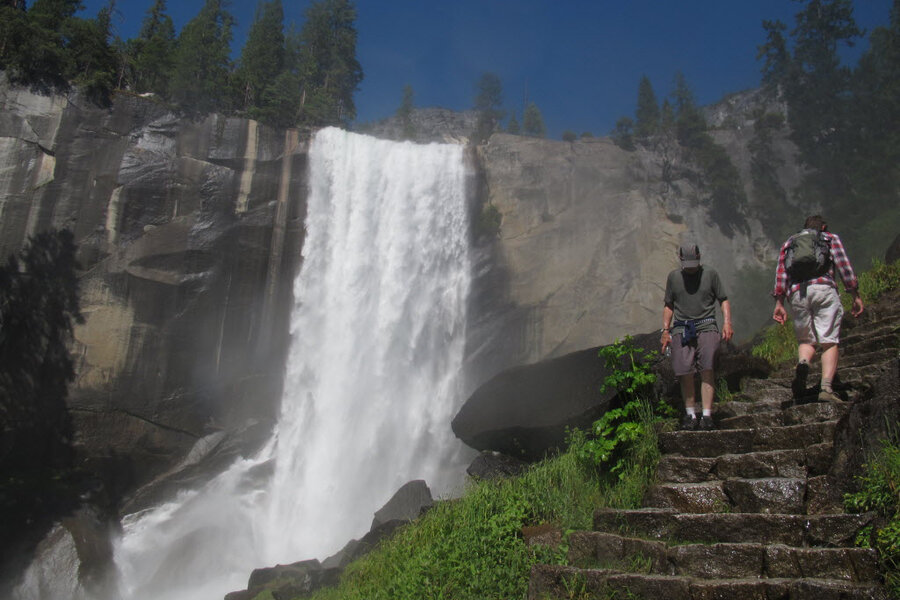Sequestration: What will happen to national parks?
Loading...
| Sacramento, Calif.
The towering giant sequoias at Yosemite National Park would go unprotected from visitors who might trample their shallow roots. At Cape Cod National Seashore, large sections of the Great Beach would close to keep eggs from being destroyed if natural resource managers are cut.
Gettysburg would decrease by one-fifth the numbers of school children who learn about the historic Pennsylvania battle that was a turning point in the Civil War.
As America's financial clock ticks toward forced spending cuts to countless government agencies, The Associated Press has obtained a National Park Service memo that compiles a list of potential effects at the nation's most beautiful and historic places just as spring vacation season begins.
"We're planning for this to happen and hoping that it doesn't," said Park Service spokesman Jeffrey Olson, who confirmed that the list is authentic and represents cuts the department is considering.
Park Service Director Jon Jarvis last month asked superintendents to show by Feb. 11 how they would absorb the 5 percent funding cuts. The memo includes some of those decisions.
While not all 398 parks had submitted plans by the time the memo was written, a pattern of deep slashes that could harm resources and provide fewer protections for visitors has emerged.
In Yosemite National Park in California, for example, park administrators fear that less frequent trash pickup would potentially attract bears into campgrounds.
The cuts will be challenging considering they would be implemented over the next seven months — peak season for national parks. That's especially true in Yellowstone, where the summertime crush of millions of visitors in cars and RVs dwarfs those who venture into the park on snowmobiles during the winter.
More than 3 million people typically visit Yellowstone between May and September, 10 times as many as the park gets the rest of the year.
"This is a big, complex park, and we provide a lot of services that people don't realize," Yellowstone spokesman Al Nash said. "They don't realize we're also the water and wastewater treatment operators and that it's our job to patch potholes, for heaven's sake."
The memo says that in anticipation of the cuts, a hiring freeze is in place and the furloughing of permanent staff is on the table.
"Clear patterns are starting to emerge," the memo said. "In general, parks have very limited financial flexibility to respond to a 5 percent cut in operations."
Most of the Park Service's $2.9 billion budget is for permanent spending such as staff salaries, fuel, utilities and rent payments. Superintendents can use about 10 percent of their budgets on discretionary spending for things ranging from interpretive programs to historic-artifact maintenance to trail repair, and they would lose half of that to the 5 percent cuts.
"There's no fat left to trim in the Park Service budget," said John Garder of the nonprofit parks advocacy group the National Park Conservation Association. "In the scope of a year of federal spending, these cuts would be permanently damaging and save 15 minutes of spending."
For years Congress has been cutting funding to the National Park Service, and in today's dollars it is 15 percent less than a decade ago, said Garder, who is the nonprofit's budget and appropriations legislative representative in Washington, D.C. Park spending amounts to one-fourteenth of 1 percent of the federal budget, he said.
One in five international tourists visits one of America's 398 national parks, research shows, and the parks are one-third of the top 25 domestic travel destinations. If the cuts go though, the memo shows national parks will notice fewer services, shorter hours and the placing of some sensitive areas completely off-limits to visitors when there are too few staff members to protect resources.
The Park Service also writes that communities around parks that depend on tourism to fill their hotels and restaurants would suffer.
Cape Cod National Seashore would close the Province Land Visitor Center, shutting out 260,000 people from May through October. Without monitors to watch over nesting birds, large sections of the Great Beach would close to keep eggs from being trampled.
The Great Smoky Mountains National Park will close five campgrounds and picnic areas, affecting 54,000 visitors.
The more than 300,000 visitors who use Grand Teton's Jenny Lake Visitor Center in Wyoming would be sent to other areas of the park. The park's nonprofit association would lose a quarter million dollars in sales.
In Yosemite National Park, maintenance reductions mean the 9,000-foot-high Tioga Pass, the park's only entrance from the east, would open later in the year because there would be no gas for snow plows or staff to operate them. The town of Mammoth Lakes in the eastern Sierra depends on Yosemite traffic to fill its hotels and restaurants.
Even programs important to the long-term environmental health of spectacular places are in jeopardy. In Yosemite, an ongoing project to remove invasive plants from the entire 761,000 acres would be cut. The end of guided ranger programs in the sequoia grove would leave 35,000 visitors unsupervised among the sensitive giants. And 3,500 volunteers who provide 40,000 hours on resource management duties would be eliminated for lack of anyone to run the program.
Glacier National Park in Montana would delay the opening of the only road providing access to the entire park. When the Going-to-the-Sun Road has closed previously, it meant $1 million daily in lost revenue, the memo said.
Even Declaration House in Pennsylvania, the place where Thomas Jefferson drafted the Declaration of Independence, wouldn't be spared. Nor would comfort stations on the Natchez Trace Parkway in Mississippi.
"We remain hopeful that Congress is able to avoid these cuts," said Olson, the national parks spokesman.
Associated Press writer Mead Gruver in Cheyenne, Wyo., contributed to this report.







